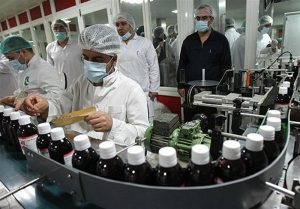
Strategic Workforce Development in Healthcare: A Pathway to Sustainable Employment & Economic Growth
Barkat Health & Pharmaceutical Group: Attracting and training specialized talent, particularly in advanced drug development and biotechnology, is crucial for transforming healthcare systems and driving economic growth.
Skilled Workforce in Healthcare & Pharmaceuticals
A successful healthcare system relies not only on financial resources and infrastructure but also on a highly skilled workforce capable of addressing complex medical and pharmaceutical challenges. As healthcare evolves, professionals must possess cutting-edge scientific knowledge and the flexibility to adapt to an ever-changing industry.
In critical sectors like pharmaceutical sciences and biotechnology, professionals must make informed, evidence-based decisions to develop effective, safe, and high-quality medicines. As drug development becomes more complex, the workforce must be not only well-trained but also proficient in applying theoretical knowledge to real-world challenges.
Promoting Sustainable Employment in Healthcare
A key goal of healthcare strategies is to create sustainable employment opportunities. Expanding career prospects in healthcare and pharmaceuticals improves medical services and drives economic growth, workforce expansion, and poverty reduction.
The pharmaceutical industry, a cornerstone of healthcare systems, ensures the availability of essential medicines. Investing in workforce development within this sector strengthens healthcare infrastructure and promotes economic stability and improved public health outcomes.
This analysis explores the essential role of specialized human capital in the pharmaceutical sector and how it fosters sustainable employment, highlighting the importance of strategic collaboration, innovation, and advanced education to meet industry demands.
Growing Need for Specialized Professionals in Pharmaceuticals
The pharmaceutical sector is one of the most advanced and complex industries in healthcare, requiring a highly skilled workforce. Countries aiming for pharmaceutical self-sufficiency, like Iran, face challenges in meeting international production standards while nurturing domestic innovation and capacity-building.
The demand for highly trained professionals spans several domains, including:
- Research and Development (R&D): Driving drug discovery, clinical trials, and pharmaceutical innovation.
- Pharmaceutical Manufacturing and Engineering: Overseeing complex production processes while maintaining stringent quality standards.
- Quality Control and Regulatory Affairs: Ensuring compliance with global pharmaceutical regulations and safety guidelines.
- Process Management and Supply Chain Optimization: Optimizing efficiency in production, packaging, and distribution.
As these demands grow, attracting, training, and retaining specialized talent has become a strategic imperative for pharmaceutical industry expansion.
Challenges in Workforce Training: Bridging the Gap Between Theory and Practice
Despite the growing demand, workforce development in pharmaceuticals faces challenges:
- Outdated Training Models: Many programs focus primarily on theory, lacking practical, industry-relevant experience.
- Alignment with International Standards: Curricula must evolve to reflect advancements in Good Manufacturing Practices (GMP), biotechnology, and regulatory compliance.
- Limited Practical Exposure: Real-world skills in production, research, and clinical settings remain underdeveloped.
To address these challenges, training programs must integrate emerging industry needs and equip the workforce with both theoretical and practical expertise.
Education & Workforce Development
An effective workforce strategy depends on continuous education and upskilling. Given the rapid pace of scientific discovery and technological advances, professionals must engage in lifelong learning to stay at the forefront of the field.
Bridging the Knowledge-Application Gap: Integrating Theory with Practical Experience
A successful workforce development strategy combines theoretical learning with hands-on experience. The pharmaceutical industry, particularly in R&D, requires professionals who can translate scientific concepts into real-world solutions. Practical skills—like operating advanced lab equipment and mastering drug formulation techniques—are equally vital.
Key strategies for effective training include:
- Specialized Certification Programs: Targeted training in fields such as pharmaceutical quality management, biotechnology, and production engineering.
- Industrial Internships and Residency Programs: Direct engagement with pharmaceutical manufacturers and research institutions.
- Collaborative Training Initiatives: Partnerships with industry leaders, regulators, and academia to provide comprehensive educational experiences.
By fostering a culture of continuous learning, the pharmaceutical sector can maintain a competitive workforce in the global marketplace.
Building Sustainable Employment & Economic Growth in Healthcare
A primary goal of workforce development in pharmaceuticals is to create long-term employment opportunities. These positions not only enhance the availability of essential medicines but also drive economic growth and improve societal well-being.
Key Drivers of Sustainable Employment in Pharmaceuticals
To ensure long-term career prospects, several factors must be addressed:
- Investment in Talent Development: Building educational infrastructure, research centers, and technical training facilities.
- Encouraging Private Sector Participation: Attracting investments from both domestic and international pharmaceutical companies to expand job opportunities.
- Policy Incentives and Government Support: Offering financial incentives, tax benefits, and research grants to support workforce development.
Sustainable employment reduces unemployment, particularly among young professionals, while boosting private sector participation in national healthcare initiatives.
Startups & Knowledge-Based Enterprises in Workforce Expansion
Pharmaceutical innovation has given rise to startups and knowledge-based enterprises, which are transforming workforce development. These companies leverage cutting-edge research, AI, and novel drug formulations, contributing to industry progress.
Creating an Innovation Ecosystem
Building a collaborative ecosystem of startups, academic institutions, and established pharmaceutical firms encourages:
- Job Creation: Expanding opportunities in research, production, marketing, and regulatory affairs.
- Technological Advancements: Accelerating automation, AI-driven drug discovery, and precision medicine.
- Knowledge Transfer and International Collaboration: Enhancing global competitiveness through partnerships and cross-border research.
By embracing entrepreneurial innovation, the pharmaceutical industry can enhance workforce capabilities and achieve greater self-sufficiency.
International Collaboration: Strengthening Workforce Competencies
In an era of rapid technological progress, international collaboration is vital for workforce development. Engaging with global leaders through:
- Joint Research Programs and Training Initiatives
- Scholarships and Academic Exchange Programs
- Multinational Pharmaceutical Partnerships enables the domestic workforce to access cutting-edge methodologies and best practices, strengthening national pharmaceutical capabilities and aligning with global standards.
Policy and Strategic Frameworks for Workforce Development
Governments play a key role in shaping policies that attract, train, and retain specialized professionals in the pharmaceutical sector. Strategies include:
- Investment in Higher Education and Technical Training
- Providing Incentives for Pharmaceutical Workforce Development
- Supporting Research and Development Initiatives
Forward-thinking policies can drive growth in the pharmaceutical industry while fostering a self-sustaining healthcare system.
Conclusion: Establishing a Global Pharmaceutical Hub Through Workforce Excellence
A holistic approach to workforce development—encompassing education, innovation, and international collaboration—can position nations like Iran as leaders in pharmaceutical sciences. By investing in specialized human capital, promoting continuous learning, and leveraging technological advancements, the pharmaceutical sector can achieve sustainable growth, improve public health, and drive economic prosperity.
Strategic workforce development enables the pharmaceutical industry to not only meet national healthcare needs but also emerge as a global player in the pharmaceutical landscape.
-
وقتی زمین حرف میزند: میدان مغناطیسی و بازیهای پنهان با مغز و خواب

-
رشد چشمگیر 201 درصدی درآمد«دالبر» در 6 ماه نخست 1404

-
امنیت سایبری؛ پیشران سلامت پایدار در عصر دیجیتال

-
مهمترین سرمایه امروز ما وحدت ملی است/ رفتار مردم خلاف محاسبات دشمن بود

-
وقتی علم میان سکوت و شیمی نفس کم میآورد؛ روایتی از تنهایی آزمایشگاهها!

-
کارکنان خط تولید، سربازان گمنام سلامت؛ نگاهی به سلامت روان در کارخانههای داروسازی

-
ضرورت همافزایی دولت و بخش خصوصی؛ حفظ انسجام اقتصادی، اجتماعی و امنیتی کشور

-
تابآوری کودکان در بحران جنگ؛ راهکارهای مقاومتی در سایه ایستادگی ایران و شکست دشمن

